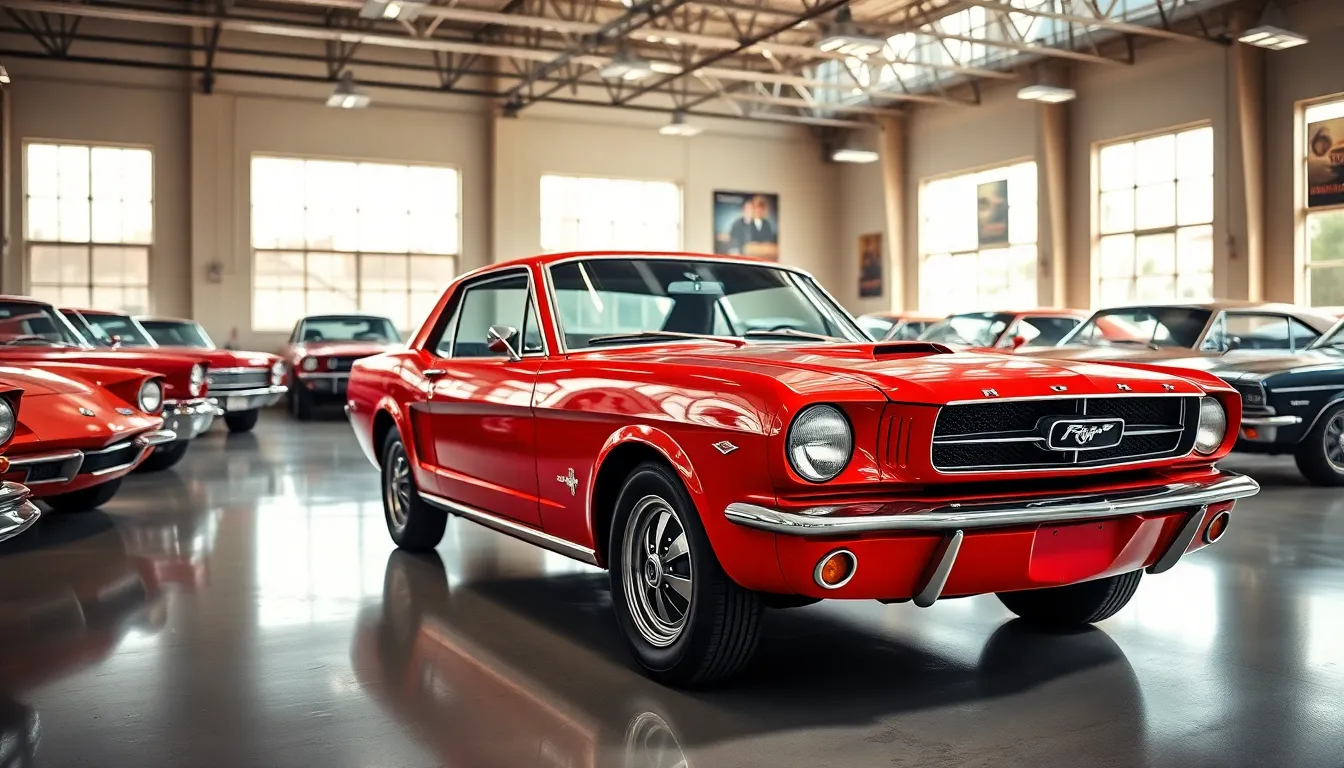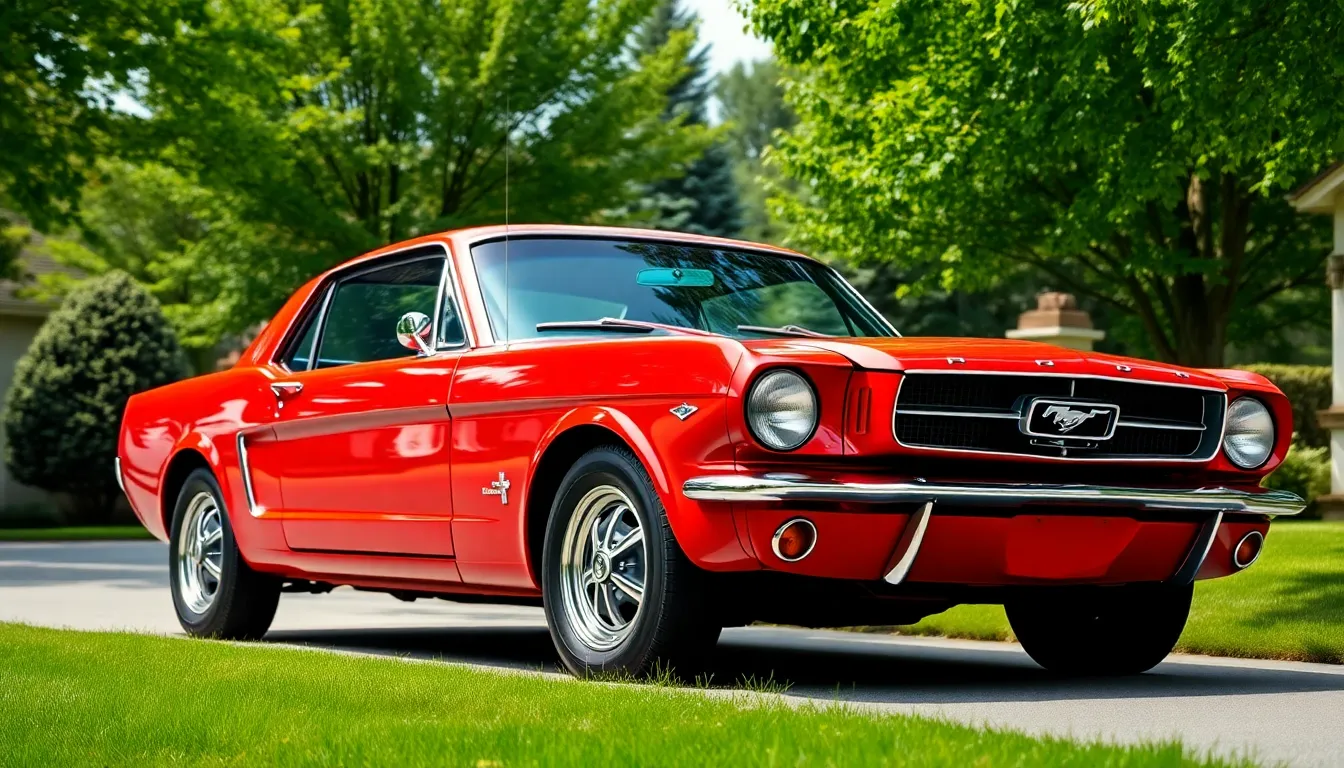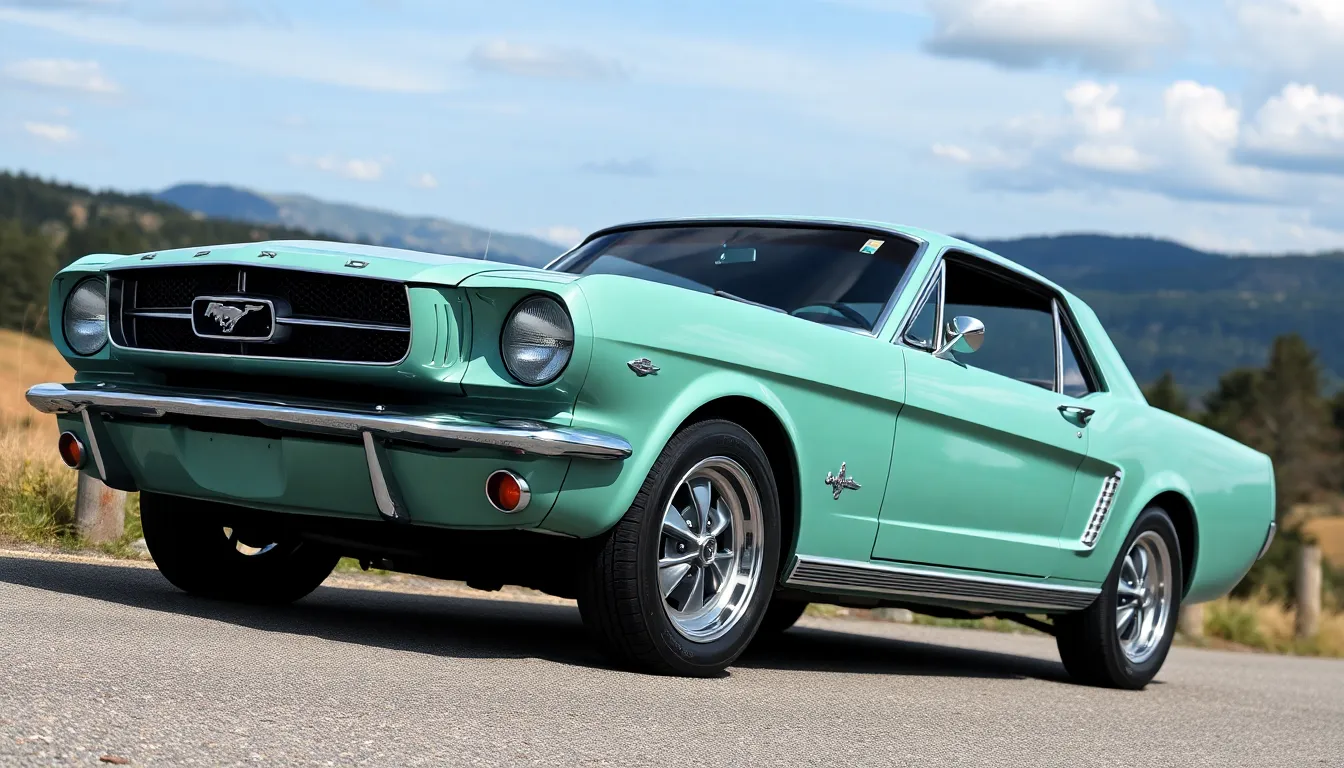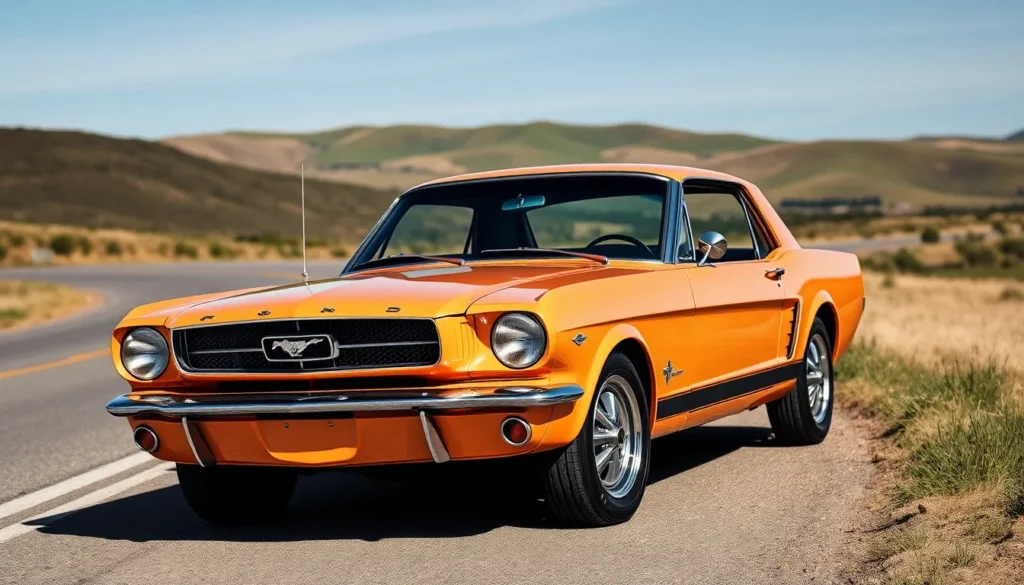The 1966 Ford Mustang stands as one of the most iconic muscle cars ever built, capturing hearts and igniting passions for over five decades. We’re talking about the pony car that defined an entire generation and transformed Ford’s reputation forever. This wasn’t just another vehicle rolling off the assembly line – it was automotive history in the making.
What made the ’66 Mustang so special? We’ll explore how Ford refined their original pony car concept with improved performance options, sleeker styling updates, and enhanced comfort features that set it apart from its predecessors. From the base 200-cubic-inch inline-six to the thunderous 289 V8, this model year offered something for everyone.
Whether you’re a classic car enthusiast, potential buyer, or simply curious about automotive legends, we’ll dive deep into what makes the 1966 Mustang a timeless treasure that continues commanding respect on roads and at car shows nationwide.
Design and Styling Changes
The 1966 Ford Mustang featured refined aesthetics that distinguished it from the inaugural 1965 model. Ford engineers implemented subtle yet meaningful updates that enhanced both visual appeal and functionality.
Exterior Updates
Ford redesigned the front grille with a distinctive honeycomb pattern that replaced the previous horizontal bars. Chrome trim around the grille opening added premium detailing that elevated the car’s appearance. The galloping horse emblem received a larger housing that made it more prominent on the front fascia.
Side ornamentation became more sophisticated with the addition of chrome spears that ran along the rear flanks. These decorative elements created visual length and emphasized the Mustang’s sporty proportions. Optional pin striping packages allowed buyers to further personalize their vehicles with contrasting accent colors.
Rear lighting elements maintained the sequential turn signal feature while incorporating improved lens clarity. The backup lights received repositioning to the rear bumper area for better visibility. Standard wheel covers adopted a new five-spoke design that complemented the updated exterior styling themes.
Interior Refinements
Dashboard instrumentation received enhanced readability through improved gauge faces and clearer numbering. The steering wheel adopted a thinner rim diameter that provided better grip and control feedback. Optional wood-grain trim became available for interior panels and provided an upscale appearance.
Seat upholstery options expanded to include new vinyl patterns and optional leather appointments in premium models. Door panels featured updated armrest designs that improved ergonomics and visual appeal. The console area received redesigned storage compartments that offered more practical functionality.
Interior lighting systems incorporated additional courtesy lamps in the door panels and footwell areas. Climate control knobs received updated labeling that made temperature and fan speed adjustments more intuitive. Optional interior trim packages allowed buyers to coordinate colors between seats, door panels, and dashboard elements.
Engine Options and Performance

The 1966 Ford Mustang offered diverse engine configurations that catered to different driving preferences and performance expectations. Ford’s engineering team refined these powerplants to deliver improved reliability and enhanced output compared to the previous model year.
Base Inline-6 Engine
The standard 200 cubic inch inline six engine served as the foundation powerplant for the 1966 Mustang lineup. This overhead valve design produced 120 horsepower at 4,400 rpm and generated 190 lb-ft of torque at 2,400 rpm. Ford engineers equipped this engine with a single barrel carburetor and solid valve lifters for dependable operation.
Fuel economy reached approximately 20 miles per gallon in combined driving conditions with the inline six configuration. The engine featured a cast iron block construction with seven main bearings that enhanced durability and reduced vibration. Ford positioned this powerplant as the economical choice for buyers who prioritized affordability over performance.
V8 Performance Variants
The 289 cubic inch V8 engine dominated the performance industry for the 1966 Mustang model year. Ford offered this engine in two distinct configurations: the two barrel version produced 200 horsepower while the four barrel variant generated 225 horsepower. Both versions delivered 282 lb-ft of torque and featured hydraulic valve lifters for smoother operation.
The high performance 289 K-Code engine represented the pinnacle of Mustang performance in 1966. This solid lifter version produced 271 horsepower at 6,000 rpm and delivered 312 lb-ft of torque at 3,400 rpm. Ford equipped K-Code engines with a four barrel Autolite carburetor, dual exhaust system, and chrome valve covers that distinguished them visually from standard variants.
Performance enthusiasts could achieve quarter mile times of approximately 15.5 seconds with the K-Code engine when paired with the appropriate transmission and rear axle ratio. The engine’s high rpm capability and aggressive camshaft profile made it the preferred choice for racing applications and spirited street driving.
Transmission Choices
Ford provided three transmission options for the 1966 Mustang to accommodate various driving styles and preferences. The standard three speed manual transmission came equipped with all engine configurations and featured synchronized gears for smooth shifting operation.
The optional four speed manual transmission enhanced performance potential with closer gear ratios and improved acceleration characteristics. This transmission paired particularly well with V8 engines and included a Hurst shifter mechanism for precise gear changes. Ford designed the four speed unit to handle increased torque loads from high performance engines.
The C4 Cruise-O-Matic automatic transmission offered convenience for daily driving situations. This three speed automatic featured a torque converter design that provided smooth power delivery and reduced driver fatigue in stop and go traffic conditions. Ford calibrated the automatic transmission to work seamlessly with both inline six and V8 engine configurations while maintaining reasonable fuel economy figures.
Notable Features and Technology

The 1966 Ford Mustang introduced several advanced features that enhanced both safety and comfort compared to previous model years. Ford engineers focused on practical improvements that made the driving experience more enjoyable and secure.
Safety Improvements
Ford equipped the 1966 Mustang with a standard padded dashboard that reduced injury risk during collisions. The company installed dual circuit master cylinder brakes as standard equipment, providing backup braking capability if one circuit failed.
Safety door latches replaced the previous year’s design, featuring improved mechanisms that prevented accidental opening during impacts. These latches met new federal safety regulations that took effect in 1966.
The instrument panel received safety glass covering to protect occupants from sharp edges during accidents. Ford also added breakaway interior mirror mounts that detached upon impact rather than creating dangerous projectiles.
Optional seat belts became available in both front and rear positions, though many buyers still considered them unnecessary accessories. The company positioned these belts as important safety equipment even though low consumer adoption rates.
Comfort and Convenience Upgrades
Air conditioning became a popular factory option for the 1966 model year, featuring improved cooling capacity and quieter operation than aftermarket units. The system integrated seamlessly with the dashboard controls and maintained consistent temperature regulation.
Power steering emerged as a frequently ordered option, reducing steering effort by approximately 75% compared to manual systems. This feature proved especially valuable in parking situations and low speed maneuvering.
Interior lighting received important upgrades including courtesy lights in door panels and under dash illumination for instrument visibility. Map lights became available as part of the interior décor group package.
The AM/FM radio option provided superior sound quality through upgraded speakers mounted in the dashboard and rear package shelf. Ford offered this radio with both manual and automatic tuning capabilities.
Tinted glass options included windshield tinting and complete tinted glass packages that reduced interior heat buildup and glare. These options proved particularly popular in southern markets where sun exposure presented daily challenges.
Remote control outside mirrors allowed drivers to adjust mirror positions from inside the vehicle, eliminating the need to manually position mirrors from outside. This convenience feature appealed to buyers seeking modern amenities in their sports car.
Production Numbers and Variants

Ford manufactured 607,568 Mustangs during the 1966 model year, establishing it as one of the most successful production runs in automotive history. These impressive numbers reflected the model’s widespread appeal across three distinct body styles and various special packages.
Coupe, Convertible, and Fastback Models
The hardtop coupe dominated 1966 Mustang production with 499,751 units manufactured, accounting for 82.2% of total output. This two-door configuration featured a traditional roofline and remained the most affordable entry point into Mustang ownership at $2,416.
Convertible models accounted for 72,119 units during 1966 production, representing 11.9% of total manufacturing. Ford priced these open-air variants at $2,653, making them the most expensive standard Mustang configuration. The convertible featured a power-operated soft top and additional structural reinforcements to maintain chassis rigidity.
Fastback variants, designated as the 2+2 model, comprised 35,698 units or 5.9% of 1966 production numbers. Priced at $2,607, the fastback introduced a sleek roofline that swept dramatically toward the rear deck. This body style appealed particularly to performance-oriented buyers who preferred the sportier aesthetic and improved aerodynamic profile.
| Body Style | Units Produced | Percentage of Total | Base Price |
|---|---|---|---|
| Hardtop Coupe | 499,751 | 82.2% | $2,416 |
| Convertible | 72,119 | 11.9% | $2,653 |
| Fastback 2+2 | 35,698 | 5.9% | $2,607 |
Special Editions and Packages
The GT Equipment Group emerged as the premier performance package for 1966, available across all three body styles. This option included the 271-horsepower K-Code 289 V8 engine, dual exhaust systems, front disc brakes, and distinctive GT badges. Ford offered the GT package on 13,800 hardtop coupes, 3,190 convertibles, and 7,380 fastback models.
Sprint packages provided buyers with unique exterior color combinations and interior appointments during the 1966 model year. The Sprint 200 featured the base inline-six engine with distinctive blue accent striping, while the Sprint package enhanced V8-equipped models with special paint schemes and interior trim combinations.
Pony Interior packages transformed cabin aesthetics with embossed running horse motifs on seat upholstery and door panels. This option complemented various exterior color combinations and provided buyers with a more distinctive interior environment compared to standard vinyl trim options.
Rally-Pac instrumentation groups mounted a tachometer and clock assembly on the steering column, appealing to performance-minded drivers who demanded precise engine monitoring capabilities. These gauge clusters became particularly popular among buyers who selected higher-performance engine configurations and manual transmission options.
Collectibility and Market Value

The 1966 Ford Mustang stands as one of the most sought-after classic cars in today’s collector market. Values have steadily climbed over the past decade as enthusiasts recognize this model’s historical significance and exceptional build quality.
Current Market Trends
Market data shows impressive appreciation across all 1966 Mustang variants since 2020. Base inline-six models typically range from $18,000 to $35,000 depending on condition and mileage. Standard 289 V8 coupes command prices between $25,000 and $45,000 for good examples.
Performance K-Code 289 models represent the premium segment of the market. Concours-quality K-Code fastbacks regularly sell for $75,000 to $125,000 at major auctions. Convertible K-Code variants achieve similar pricing due to their rarity and open-air appeal.
| Variant | Condition | Price Range |
|---|---|---|
| Inline-6 Coupe | Good | $18,000 – $35,000 |
| 289 V8 Coupe | Excellent | $25,000 – $45,000 |
| K-Code Fastback | Concours | $75,000 – $125,000 |
| K-Code Convertible | Show Quality | $80,000 – $130,000 |
GT Equipment Group cars consistently outperform base models in auction results. Documentation proving original GT status adds 20-30% to market values. Matching numbers engines and transmissions create additional premiums for serious collectors.
Regional markets show distinct preferences that affect pricing. West Coast buyers favor fastbacks while East Coast collectors gravitate toward convertibles. Midwest markets demonstrate strong demand for original paint survivors regardless of body style.
Investment Potential
Investment fundamentals strongly favor the 1966 Mustang’s long-term appreciation prospects. Production numbers of 607,568 units ensure reasonable availability while maintaining collectible status. This balance prevents extreme rarity that prices out mainstream collectors.
Demographic trends support continued value growth as baby boomers enter prime collecting years. Generation X buyers increasingly view these cars as attainable alternatives to earlier Mustangs. Millennials appreciate the 1966 model’s blend of classic styling and improved reliability compared to 1964½ and 1965 variants.
Original unrestored examples present the strongest investment opportunities. Survivor cars with documented ownership history and maintenance records command premium pricing. Patina and authenticity matter more to today’s collectors than perfect paint and chrome.
K-Code 271 horsepower models offer the best appreciation potential within the 1966 lineup. These high-performance engines represent just 5% of total production yet account for 40% of top auction results. Factory air conditioning and four-speed manual transmissions create additional desirability factors.
Restoration costs influence investment calculations significantly. Professional rotisserie restorations typically require $40,000 to $70,000 depending on the car’s starting condition. DIY enthusiasts can reduce these costs but must factor time investments spanning multiple years.
International demand continues expanding as European and Asian collectors discover American muscle cars. Export regulations favor post-1966 models but grandfathering provisions maintain strong overseas interest in this transitional year.
Ownership Experience

Owning a 1966 Ford Mustang provides a distinctive blend of classic car charm and manageable maintenance requirements. The experience combines the thrill of driving an iconic muscle car with practical considerations that vary significantly based on engine choice and overall condition.
Reliability and Maintenance
The 1966 Mustang demonstrates remarkable reliability for a vehicle approaching 60 years of age. Base 200 cubic inch inline six engines typically deliver consistent performance with proper maintenance, requiring oil changes every 3,000 miles and regular tune ups every 6,000 miles. Standard 289 V8 engines maintain good reliability when owners address common issues like carburetor adjustments and ignition timing.
High performance K-Code 289 engines demand more frequent attention due to their solid lifter camshafts requiring valve adjustments every 10,000 miles. Cooling systems in V8 models benefit from upgraded radiators and modern coolant to prevent overheating during summer driving. Electrical components including generators, voltage regulators, and wiring harnesses often require updates after five decades of service.
Transmission maintenance varies by type, with three speed manuals proving most durable and four speed units requiring synchronized gear oil changes every 30,000 miles. C4 automatic transmissions perform reliably when fluid changes occur every 25,000 miles and bands receive periodic adjustments. Brake systems benefit from conversion to modern brake fluid and periodic master cylinder rebuilds.
Common maintenance items include carburetor rebuilds every 50,000 miles, fuel pump replacements, and suspension component refreshing. Rust prevention becomes critical in northern climates where road salt exposure accelerates corrosion in floor pans, fender wells, and frame rails.
Parts Availability
Parts availability for 1966 Mustang restoration and maintenance ranks among the best in the classic car hobby. Ford manufactured over 600,000 units, creating substantial demand that supports a thriving aftermarket industry with companies like NPD, CJ Pony Parts, and Mustangs Plus offering comprehensive catalogs.
Reproduction body panels including quarter panels, floor pans, and fenders maintain high quality standards and reasonable pricing between $200 to $800 per panel. Interior components like seat covers, door panels, and dashboards are widely available through multiple suppliers with options ranging from economy reproductions to concours quality pieces.
Engine rebuild components for both inline six and 289 V8 motors remain readily accessible through traditional automotive suppliers and Mustang specialists. Performance upgrades including headers, intake manifolds, and camshafts offer owners many enhancement options without compromising authenticity.
Trim pieces and exterior hardware present the greatest challenge, with some original Ford components becoming scarce and expensive. Chrome bumpers, grille assemblies, and emblems often require professional restoration services costing $300 to $1,200 per piece. Weather stripping and rubber seals are manufactured by specialized companies ensuring proper fit and appearance.
Electronics including gauges, switches, and radio components maintain good availability through companies specializing in vintage Ford parts. Modern upgrades like electronic ignition systems and alternator conversions provide improved reliability while maintaining period appearance. International suppliers expand options further, though shipping costs and lead times may extend project timelines.
Comparison to Other Model Years

The 1966 Ford Mustang stands distinctly apart from its predecessor and successors through exact design refinements and engineering improvements. Ford’s 1965 inaugural model established the pony car template, but our 1966 variant enhanced that foundation with measurable upgrades across multiple systems.
Manufacturing statistics reveal the 1966 model’s production success compared to adjacent years. Ford produced 607,568 units in 1966, exceeding the 1965 model’s 559,451 units by 48,117 vehicles. Production numbers for 1967 reached 472,121 units, representing a 22% decline from the 1966 peak.
| Model Year | Total Production | Hardtop Coupe | Convertible | Fastback |
|---|---|---|---|---|
| 1965 | 559,451 | 501,965 | 101,945 | – |
| 1966 | 607,568 | 499,751 | 72,119 | 35,698 |
| 1967 | 472,121 | 356,271 | 44,808 | 71,042 |
Engine options differentiate the 1966 model from both earlier and later years significantly. Our 1965 model offered two V8 configurations, while the 1966 introduced refined carburetion and improved breathing for the 289 engines. The K-Code high-performance 289 V8 in 1966 produced 271 horsepower, matching the 1965 output but with enhanced reliability through updated valve train components.
Styling evolution between model years reveals the 1966’s unique position in Mustang history. Chrome side ornamentation replaced the 1965’s simpler trim pieces, creating more sophisticated visual appeal. Front grille design transitioned from the 1965’s vertical bars to our distinctive honeycomb pattern, while the 1967 model would introduce larger dimensions and different proportions entirely.
Interior appointments in the 1966 model surpassed previous year offerings through expanded upholstery choices and improved instrumentation. Dashboard padding became standard equipment, differentiating it from the 1965’s optional status. Steering wheel diameter decreased from 15 inches to 14 inches, providing better driver control compared to the original design.
Safety features advanced considerably between the 1965 and 1966 model years. Federal regulations mandated dual circuit brake systems in our 1966 variant, while the 1965 used single circuit designs. Door latch mechanisms met updated safety standards, and padded sun visors became standard rather than optional equipment.
Market values demonstrate the 1966 model’s competitive position among early Mustang years. Base inline-six 1966 models trade between $18,000 and $35,000, while comparable 1965 examples range from $22,000 to $40,000. K-Code 1966 fastbacks command $75,000 to $130,000, closely matching 1965 K-Code values but often exceeding 1967 performance models by 15% to 20%.
Collector preference data shows the 1966 model year attracts exact buyer segments differently than adjacent years. Original unrestored 1966 examples present stronger investment fundamentals than heavily modified 1967 models. Documentation proving GT package authenticity adds more value to 1966 models than equivalent 1965 variants, reflecting the refined nature of the second year production.
Conclusion
The 1966 Ford Mustang represents the perfect storm of American automotive excellence. We’ve seen how Ford took everything they learned from the original 1965 model and created something even better – a car that balanced performance accessibility and timeless design.
What makes this year special isn’t just the impressive production numbers or the diverse engine lineup. It’s the way Ford listened to their customers and delivered meaningful improvements without losing the Mustang’s essential character.
For today’s enthusiasts the 1966 Mustang offers the best of both worlds. You get authentic classic car ownership with relatively manageable maintenance requirements and strong parts availability. Whether you’re drawn to the economical inline-six or the thrilling K-Code V8 there’s a 1966 Mustang that fits your driving style.
The market has clearly recognized what we’ve always known – the 1966 Mustang deserves its place among America’s greatest muscle cars.
Frequently Asked Questions
What makes the 1966 Ford Mustang special compared to other model years?
The 1966 Mustang refined the original pony car concept with improved styling, enhanced performance options, and better safety features. It featured a redesigned front grille with honeycomb pattern, updated interior instrumentation, and significant safety improvements including padded dashboards and dual circuit brakes. With 607,568 units produced, it became one of Ford’s most successful production runs.
What engine options were available in the 1966 Mustang?
The 1966 Mustang offered three main engine choices: a base 200 cubic inch inline-six producing 120 horsepower for economy, a standard 289 cubic inch V8, and the high-performance K-Code 289 V8 delivering 271 horsepower. These engines could be paired with three transmission options: three-speed manual, four-speed manual, or C4 Cruise-O-Matic automatic.
How much is a 1966 Mustang worth today?
Values vary significantly by variant and condition. Base inline-six models range from $18,000 to $35,000, while standard 289 V8 coupes command $25,000 to $45,000. High-performance K-Code models, especially fastbacks and convertibles, can sell for $75,000 to $130,000 at auctions. Original GT documentation significantly increases value.
Which 1966 Mustang variant was produced the most?
The hardtop coupe was the most popular variant with 499,751 units produced out of the total 607,568 manufactured in 1966. Convertibles accounted for 72,119 units, while the fastback models were the rarest with only 35,698 units produced, making fastbacks particularly desirable among collectors today.
Are parts readily available for 1966 Mustang restoration?
Yes, parts availability is excellent due to the model’s popularity and extensive production numbers. A thriving aftermarket industry provides reproduction body panels, interior components, and engine rebuild parts. However, some original trim pieces can be challenging to source, and original unmodified parts command premium prices among collectors.
Is the 1966 Mustang a good investment?
The 1966 Mustang shows strong investment potential with steady value appreciation since 2020. Original unrestored examples, particularly K-Code models, present the strongest opportunities. Growing international demand from European and Asian collectors, combined with limited production of high-performance variants, supports long-term appreciation prospects for well-maintained examples.
What safety features were introduced in the 1966 Mustang?
The 1966 Mustang incorporated several important safety improvements including standard padded dashboards, dual circuit master cylinder brakes, and safety door latches meeting new federal regulations. The instrument panel featured safety glass, optional seat belts were available, and various comfort features like air conditioning and power steering enhanced the overall driving experience.
How reliable is a 1966 Mustang for regular driving?
The 1966 Mustang offers manageable ownership with proper maintenance. The base inline-six and standard 289 V8 engines are reliable with consistent care, while K-Code engines require more frequent attention. Regular maintenance, rust prevention, and availability of reproduction parts make these classic cars reasonably practical for enthusiast ownership and occasional driving.











